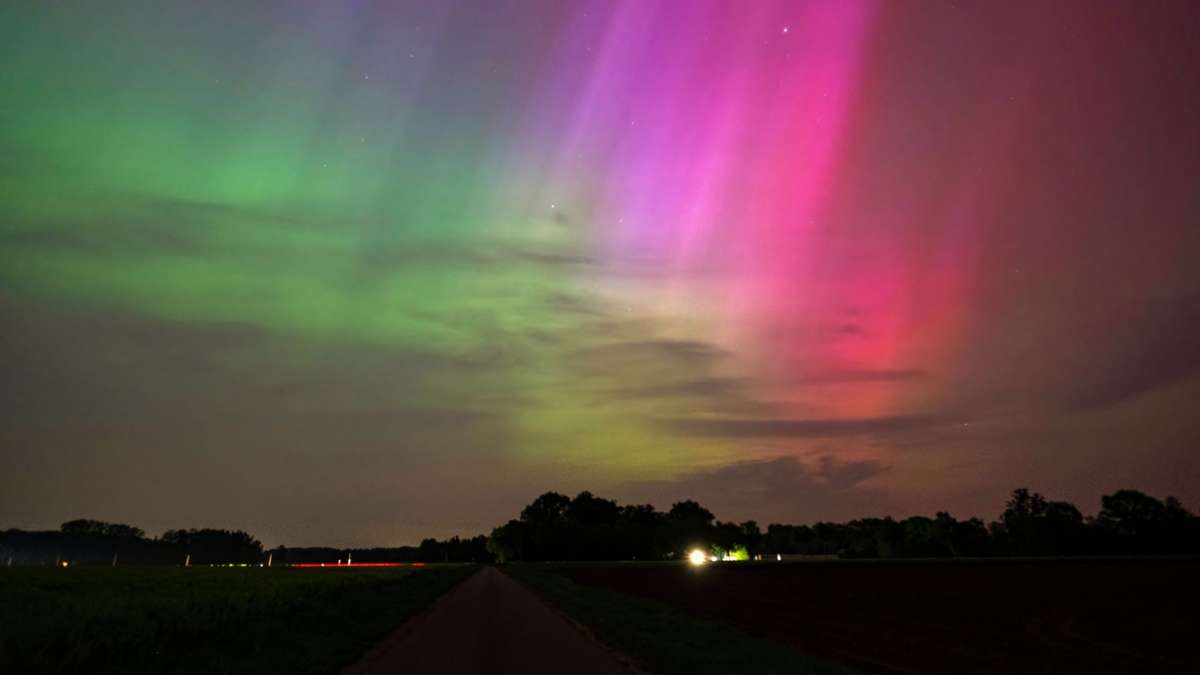Astronomy Northern Lights over Germany: Natural spectacle continues
dpa May 11, 2024 – 3:02 p.m
Play of colors: Northern lights in the sky over Bersenbrück in Lower Saxony. Photo: Markus Hibbeler/dpa
Northern lights created a colorful spectacle in the night sky over Germany at night. This is triggered by an extremely strong solar storm that is expected to last through the weekend.
Heidelberg/Offenbach – Thanks to an exceptionally strong solar storm, colorful northern lights could also be seen over many parts of Germany during the night. Anyone who missed the natural phenomenon now has another chance: the weather service is predicting a predominantly starry night ahead.
‘;
‘;
//probability
percentageRand = Math.floor(Math.random() * ((100 + 1) – 0) + 0);
isAdserver = (80
Normally, northern lights can be seen primarily in northern regions. According to Carolin Liefke from the Haus der Astronomie in Heidelberg, this time the sightings in Europe reached south to the Canary Islands, where the phenomenon – if not visible to the naked eye – was at least captured in photos. “In that respect it was very, very unusual,” said Liefke. She last saw the northern lights of this strength over 20 years ago.
Color spectacle in Germany’s night sky
On Saturday night, the Northern Lights could be seen in Freiburg in Baden-Württemberg, among other places. The natural phenomenon could also be admired in Saxony-Anhalt, for example on the Brocken and on the outskirts of Magdeburg.
In Hesse, the northern lights bathed the sky in a colorful sea of colors in dark places far away from annoying street lighting, for example in the Taunus and Hanau. The mostly cloud-free sky and moonless darkness created almost ideal conditions for observing the nightly light show.
In Bavaria, the spectacle could be seen, among other places, at Kochelsee (Bad Tölz-Wolfratshausen district) and at Wagenbrüchsee (Garmisch-Partenkirchen district). It was also possible to see the colorful lights in the Märkisch-Oderland district in East Brandenburg, in parts of Berlin as well as in several towns in Lower Saxony and several towns in North Rhine-Westphalia.
Mostly starry skies next night
Anyone who missed the Northern Lights could have another opportunity: the coming night will be mostly starlit, said the German Weather Service (DWD) in Offenbach. “At least in terms of weather, nothing stands in the way of observing and photographing the northern lights,” explained Markus Böse from the DWD. Only over the east are there a few cloud fields that could block the view of possible northern lights. Whether you can see or photograph the northern lights again in Germany and how intense they could be depends on how strong the geomagnetic storm becomes.
In fact, the US weather agency NOAA (National Oceanic and Atmospheric Administration) reported on the night from Friday to Saturday that the spectacle was not yet over. “It is highly likely that geomagnetic storms will continue into the weekend as several additional coronal mass ejections are on their way into Earth’s outer atmosphere,” NOAA said.
Strongest geomagnetic storm since 2003
These coronal mass ejections (CME) or solar storms are the cause of the rare auroras. According to the Max Planck Institute for Solar System Research, the strength of such a storm is given in three five-level categories, of which category G describes geomagnetic effects.
Regarding the current solar storm, NOAA declared on Saturday night that it had observed “G5 conditions”. This highest level was last recorded during the so-called “Halloween storms” in October 2003, which led to power outages in Sweden and damage to transformers in South Africa.
NOAA is initially not forecasting another solar storm of G5 strength for the night. According to Carolin Liefke, G3 or G4 would be enough to be able to see the northern lights with the naked eye again in good conditions here: “I would definitely lie in wait again next night and will definitely do that.”
A sunspot visible to the naked eye as the origin
According to NOAA experts, the source region of the solar storms is a large, complex sunspot cluster that is about 17 times the diameter of the Earth – this is so large that, according to Carolin Liefke, it can be seen with the naked eye without a telescope. “It was particularly beautiful to see last week and now – since the sun rotates around itself – it is moving to the edge of the sun and will disappear in the next few days,” says Liefke. If you want to catch a glimpse, you should definitely use protection such as solar eclipse glasses.
